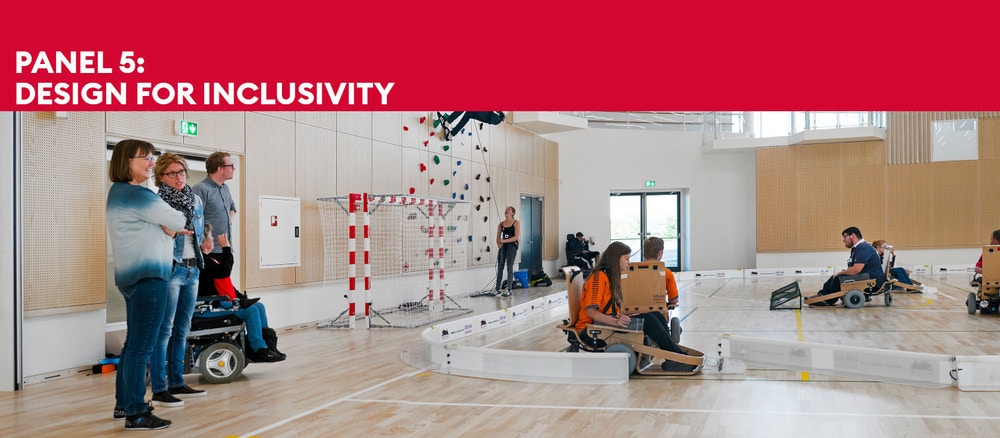PANEL 5
Panel Chairs: Magda Mostafa and Ruth Baumeister
Creating a built environment that allows as many people to participate and use it, is one of the greatest challenges for architects going forward. Anticipating and acknowledging the needs of a diverse population, from diverse backgrounds and with diverse identities requires a deep understanding of how people function, how the built environment is approached and how to make all buildings accessible for everyone.
Panel 5: Design for Inclusivity
No individual deserves to experience space in a manner that is less safe, less comfortable or less accessible as a result of their identity or challenges. Sustainability, in its most holistic definition, cannot be achieved without a collective act. This collectiveness is impossible without the inclusion of all members of society, yet our current policies and practices in architecture do not yet meet this threshold of inclusion.
Design for Inclusivity aims to critically define the constructs and categories of who exactly we are excluding, and why, in order to mindfully develop strategies to mitigate this exclusion. The categories include: gender; race & ethnicity; ability; neurodiversity; age; socio-economy; and non-human life. Submissions tackling issues of intersectionality across multiple categories, and the challenges and subsequent policies and practices that may emerge, are encouraged. Subsequently, we ask: What is an architect´s role, potential and responsibility, in creating environments that are either inclusive or exclusive?
Design for Inclusivity addresses this knowledge and practice gap in various categories, and through multiple pathways and modes, striving to expand the conventional model of scholarship by addressing: pedagogies; research tools; practices; policies; processes; and built products.
Design for Inclusivity asks for papers that engage with these perspectives and critically explore how architecture can understand, build and fulfill its active role in achieving the UN Sustainable Development Goals (SDGs).
SUB-QUESTIONS FOR DESIGN FOR INCLUSIVITY
5.1 GENDER
How is gender defined through the lens of its relationship to the built environment? How do gender-based power relations in the profession and spatialized forms of domination shape our built environment? In which ways are gender and architecture- or the perception, use and production of space- interrelated? What are the tools – from pedagogy to practice – that we can deploy to mitigate this exclusion?
5.2 RACE, ETHNICITY AND MINORITIES
What current policies are in place to exclude individuals from the built environment based on their race and ethnicity? How is race and ethnicity used to disadvantage groups from basic rights such as living in urban centers, housing, healthcare and education? What is the impact of these, and how can built environment researchers, scholars and practitioners act to shift this narrative? How can these policies be deconstructed?
5.3 ABILITY
Architecture can be disabling and/or empowering. By designing in a way that ignores the needs of all forms of ability we are excluding by design. How can we expand our definitions of mobility, perception, communication and dexterity and design with these expanded definitions as a means to be more inclusive? Are legally binding codes enough to ensure true authentic inclusion? Or are they a starting point that must be expanded? How can we codify such diverse needs? And how can we resolve conflicting needs through design?
5.4 NEURODIVERSITY
Not all ability challenges are visible. Invisible challenges include: autism spectrum; learning challenges; developmental challenges; and mental health. What role does the built environment play in disabling these user groups? How can we, as built environment practitioners, learn from this diverse perceptual model? How can we design in a way that is more facilitative, supportive and accessible for neurodiverse perceptual models?
5.5 AGE
Human life comprises of various different stages from infancy to senior years. Aging is a normal process of our human life cycle and yet our societies, and the built environment structures that support them, often either ignore or pathologize early or later stages of life. How can we design our cities, housing, healthcare and civic spaces to support inclusivity in order to consider all the different stages of life? How can design support moments of transition? Are there inclusive and typological practices that can help inform that change?
5.6 POVERTY AND SOCIO-ECONOMY
The statistical majority of our world’s population lives at or below the poverty line, largely in informal built environments with limited, if any, access to basic infrastructure such as clean water, sanitation and safe shelter. But despite this majority, our research, policies and practices still define architectural practice largely as that involved with the production of formal structures. What can we learn from informality? How can we harness the user-driven, self-sufficient locality of it, while mitigating its shortcomings? And how can we integrate this redefinition into how we educate, train and produce our future generations of architects?
5.7 THE NON-HUMAN
The idea that nature exists as something wild outside of human culture is outdated, but there is a lack of awareness in current planning practice when it comes to the importance of non-human actors, such as animals, trees, etc. How can we think of spaces as something ´more-than-human´ and by doing so, aim at including unintended aspects of the built environment? How can architects contribute to create an awareness to the needs of non-human actors not only on the level of the discipline´s critical role in urban ecology, but also by including non-human´s subjectivities in the built environment?
5.8 PANEL ++ INTERSECTIONALITY
No person is one thing, and the rich tapestry of our human condition needs an equally rich tapestry of design solutions, that views users not only from an inclusive lens but from an intersectional one. How can design tackle multiple and diverse needs? And how can we codify the infinite intersectionalities of users?
VISIT THE SIX PANELS
Panel 1
Design for Climate Adaptation
Architecture faces a grave challenge in a world struck by climate change. The built environment must adapt to changing weather patterns, higher temperatures and flooding.
Panel 2
Design for Rethinking Resources
Resources are getting scarcer, and architects need to address this issue. By using novel materials and recycling on a much greater scale, architecture can change its approach to resources..
Panel 3
Design for Resilient Communities
Communities are people, and people create communities. Architects can positively impact the lives of millions, even billions, by building for the future, and creating communities that last.
Panel 4
Design for Health
Healthy living takes place in healthy environments, and architects can help improve public health through careful planning, building and consideration.
Panel 6
Design for Partnerships for Change
Architects must foster partnerships, and work across many different professions and skills to create a sustainable and inclusive future.


